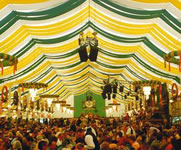The State Natural History Collections in Dresden consist of the Museum of Mineralogy and Geology, the Zoology Museum and the Central Natural History Library, which became an independent specialist natural history museum in 1728. The museums have their origins in the Elector of Saxon's collections and are among the oldest geo-scientific establishments in the world. The collections include 6.5 million rocks, minerals and fossils from sites around Saxony. The museum's work is focused on mineralogy, petrography and palaeontology. Closed on Mondays.
» www.smwk.de
Situated in the church of the former Reichklara Abbey, the Natural History Museum in Mainz was opened to visitors back in 1910 and is now the largest and most important museum of its kind in the Rhineland-Palatinate. Few other natural science museums in the world have such an extensive collection of prehistoric dinosaur tracks and insects from the Permian period on the Rhine. With more than 25,000 finds, it has a rich and varied collection of ice-age animals such as the hippo, steppe mammoth, elk, wolf, Javan rhino, giant lion, jaguar, sabre-toothed cat and the famous group of quaggas that all lived in the Rhine-Main region approx. 500,000 years ago. This extensive exhibition is guaranteed to hold your interest like no other. Closed on Mondays.
» www.staff.uni-mainz.de
With an exhibition area of 800m², the Regional Natural History Collection in Wiesbaden is one of the largest of its kind in Germany. Featuring exhibits from the world of zoology, botany, geology, mineralogy, palaeontology and ethnography, the collections have been looked after and developed by museum staff since 1829. One of the museum's true gems is the insect collection of Johann Christian Gerning, in particular the butterflies. Guided tours offered.
» www.nws-wiesbaden.de
Opened in Aalen in 1977, the largest municipal museum of geology and palaeontology in Baden-Württemberg presents millions of years of the earth's history. In 1864, the prehistoric researcher C. H. Mayer named the particularly well-defined, lower brown Jurassic layers "Aalenium" after the city Aalen. This designation is still used around the world today. Aalen is internationally well known as a site where these layers of rock are typically found. Covering three floors, the collection is grouped according to current scientific thinking and gives an excellent insight into the development of Swabia's geological structure. Easy-to-read display boards provide basic geological facts and explain fossil organisms. Particular highlights include a diverse collection of wonderful fossils of dinosaurs, squid, sea lilies and giant ammonites from a primordial ocean. Closed on Mondays, guided tours on request.
» www.urweltmuseum-aalen.de
The Jurassic Museum in Eichstätt is a natural history museum set in historical Willibaldsburg castle. It illustrates the regional and geological history of the southern Franconian Alb. The main focus of the exhibition is the famous collection of 150 million year old Solnhofen limestone fossils from the late Jurassic period. Its most valuable treasure is the archaeopteryx, a prehistoric bird. The museum makes a smooth transition from fossilized to living animals in its aquarium room featuring a real coral reef. Highlights include "living fossils" such as the Nautilus, Xiphosura and Lepisosteidae. Closed on Mondays, 1 Jan., Shrove Tuesday, 1 Nov., 24, 25 & 31 Dec. Guided tours and trips on request, multimedia show.
» www.jura-museum.de



